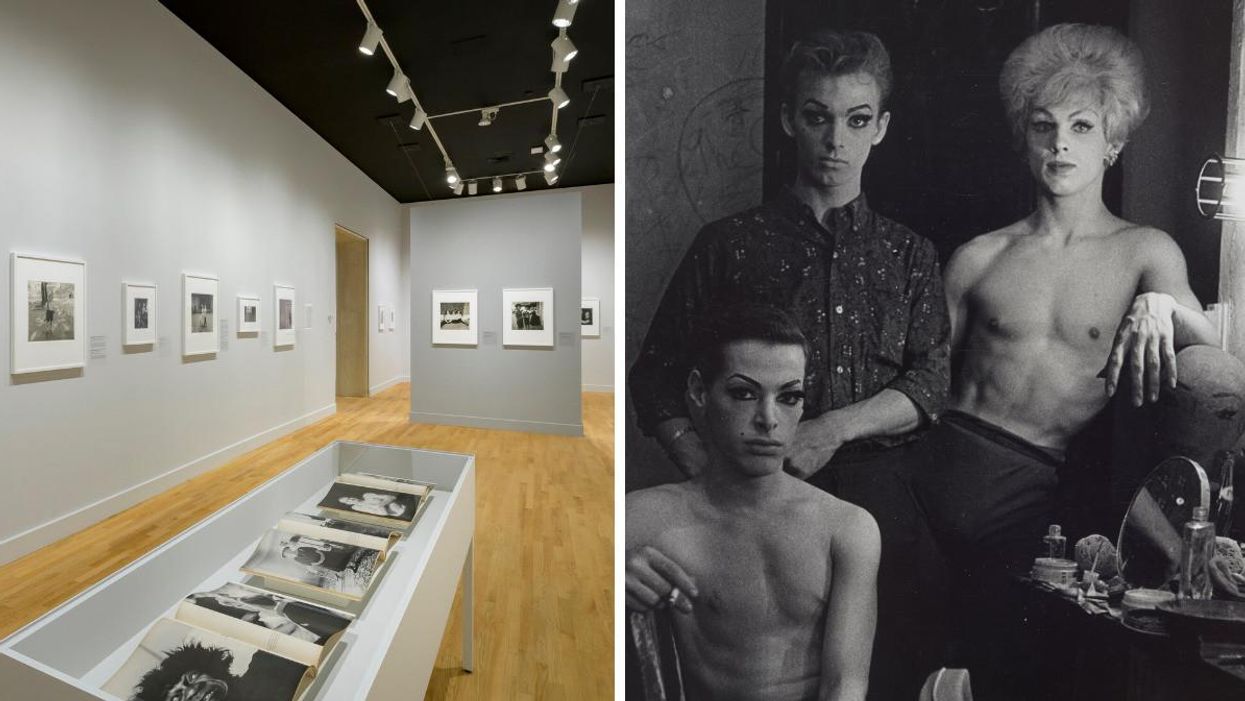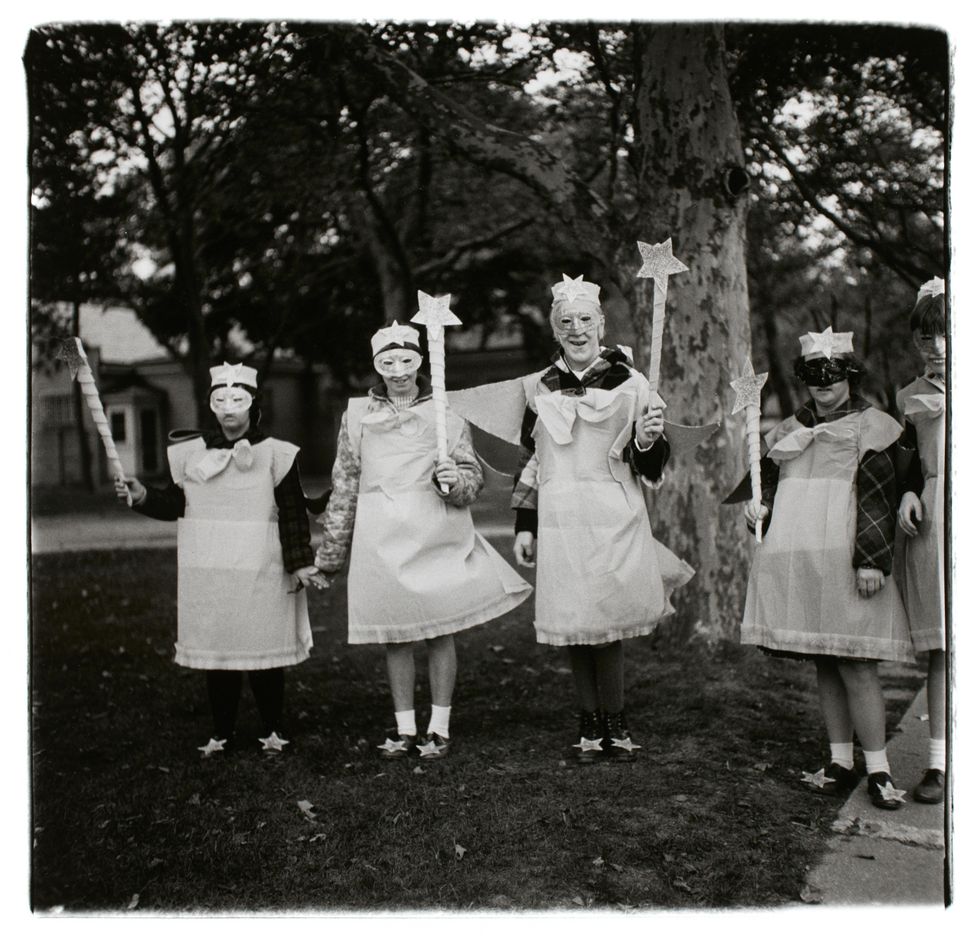Montreal's Museum Of Fine Arts Has A Powerful Photo Exhibit Of People Deemed Freaks & Rejects
One portrait inspired 'The Shining' twins. 👭

View of the exhibition 'Diane Arbus: Photographs, 1956-1971' at the Montreal Museum of Fine Arts. Right, A black and white photo by Diane Arbus, titled 'Three female impersonators' (1962).
Sex workers, circus performers, drag queens and disabled children peer out from the walls of an exhibit at the Montreal Museum of Fine Arts (MMFA). Some of their faces may seem familiar, like the ghostly pair of identical sisters holding hands who inspired the iconic twins in Stanley Kubrick's The Shining, or the peculiar child gripping a toy grenade in a park who became the basis for Matt Groening's Bart Simpson.
Diane Arbus: Photographs, 1956-1971 not only brings into focus the artist's decades-long impact on pop culture, but also her humanization of marginalized people.
The exhibit features 90 portraits of people who lived on the fringes of American society. In one series, Arbus captured snapshots of eccentrics whom she encountered on the streets of New York. A teenage couple poses in one shot, seeming far older than their years, while an elderly woman wearing an ornate lace outfit eats dinner alone at a restaurant.
A different series showcases carnival performers, like a heavily tattooed strongman, a knife eater and a bearded lady, focusing less on their profession and more on their personalities.
Another still, depicts celebrities like funk musician James Brown and feminist writer Germaine Greer, stripping away their glamourous identities and leaving a vulnerable glimpse into their lives.
"You can spend a lot of time with these photos because they are so rich with details," exhibition and MMFA curator Anne Grace told MTL Blog during a tour.

Some of Arbus' shots will have you asking, "how did she gain access to this moment?" One portrait shows a dominatrix embracing her much older client, while another shows a topless burlesque performer perched confidently in her changing room. Another still features lesbian icon Stormé DeLarverie, who is often credited for sparking the 1969 Stonewall Riots that led to the modern fight for queer and trans rights.
Arbus' affection for her subjects comes across not just through her words but in their portraits, letting the depth of their personalities shine through.
In a nearby frame, a disabled couple who Arbus met at a dance embraces in their living room. The caption quotes the photographer: "he is [mentally handicapped] and terribly tall and thin and she is radiant, maybe three and a half feet tall with curly red hair like Maureen O'Hara (and tiny limbs and crutches)… Never saw anything like that."

Each photo offers an intriguing narrative that's up to viewers to decipher. When the collection is viewed altogether, it reveals more about Arbus than her subjects — most notably, her ability to connect with people who existed outside the mainstream.
"I work from awkwardness. By that, I mean I don't like to arrange things. If I stand in front of something, instead of arranging it, I arrange myself," Arbus is quoted in one caption.
A snapshot of one of her notebooks grants insight into her radical vision of various series and treatment of her photography practice as an exercise in anthropology, documenting all walks of life.

The exhibit traces Arbus' evolution over a decade and a half, from the start of her legendary career in 1956 until the photographer died by suicide in 1971 at the age of 48. She left a body of work that was already critically acclaimed and left a lasting impact on other artists and mainstream society.
"We are so excited to introduce Arbus, through this exhibition, to a new generation of museum-goers," said Art Gallery of Ontario (AGO) photography curator Sophie Hackett, who also assembled the exhibition.
"In fifteen short years, she produced perhaps the most compelling body of portraits the 20th century had seen."
Diane Arbus: Photographs, 1956-1971
Where: Montreal Museum of Fine Arts, 1380, rue Sherbrooke Ouest
When: September 15, 2022 to January 29, 2023
- Here's How To See The Montreal Yayoi Kusama Exhibit Without ... ›
- The Yayoi Kusama Exhibit In Montreal Opens A Window Into Her ... ›
- A New OASIS Immersion Show Is Coming To Montreal & It'll Be Like Stepping Into A Movie - MTL Blog ›
- 7 Underrated Montreal Museums That Might Just Blow Your Mind - MTL Blog ›
- 'Deadpool' Director Shawn Levy Shared The 3 Montreal Spots Ryan Reynolds Should Visit - MTL Blog ›
- Montreal's New Immersive Van Gogh Exhibit Is Now Open & Totally Mesmerizing (FIRST LOOK) - MTL Blog ›
- These Montreal Maps Show Where To Find All The City's Public Art & What Each Piece Means - MTL Blog ›

